When you grow your own potatoes you have several options of when to harvest or dig up your potatoes, and how to cure and store your potato harvest.
This post may contain affiliate links at no additional cost to you. By making your purchases through the links on this website, IMSL may make a small percentage at no direct cost to you. IMSL only promotes products we use & truly believe in. Please refer to my Privacy & Disclosures for further information. IMSL thanks you for your support!
I love growing root crops. And potatoes are high on that list of favorites to grow. Why? It’s like un-wrapping a gift, that feeling of enthusiastic anticipation of “what could it be”, or in this case how big or how many!
There may be nothing more fun than harvesting carrots, garlic, or potatoes and finally, after many months of being hidden from the world, seeing just how big or how many of those hidden gems there actually are!
TWO TYPES OF GARDEN POTATOES
You may be scratching your head right at this moment, thinking “what the heck is she talking about, two types of potato’s”. And I don’t blame you. After all, a potato is, well, a potato 😂. It really just boils down to maturity of the potato plant itself.
NEW POTATOES DEFINED
You may be familiar with those small potato’s labeled “new potatoes” which become more readily available around the holiday’s. These potatoes are also often referred to as “young potatoes”or “baby potatoes”.
New potatoes are those that have been harvested early, when they are still immature. Harvested shortly after the foliage flowers (more on that below). These are the potatoes that you will want for fresh eating or short term storage, typically only a few weeks life span.
They are typically small, round and eaten with the skin on as they are very tender still, often referred to as “waxy” or “smooth” due to their low starch content.
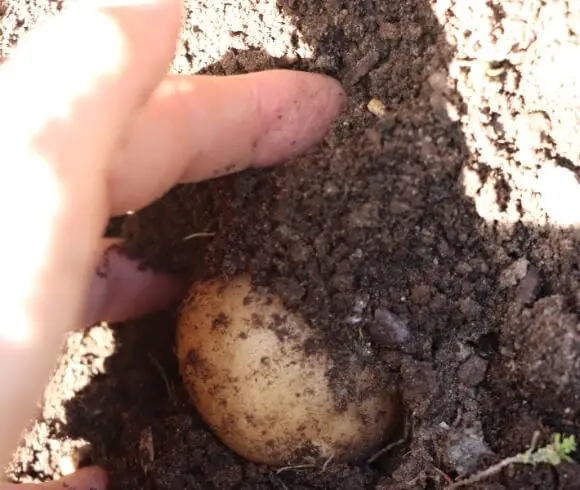
Here on the hill, we harvest new potatoes throughout the growing season by gently digging in the side of the potato mound with a hand and “stealing” or taking just a few from the plant itself and allowing the rest of the potato plant to continue growing. Don’t forget to push the soil back around the exposed plant!
MAINCROP POTATOES DEFINED
Maincrop potatoes are those that are fully mature and are typically harvested for curing and storing long-term. These potatoes are the ones that have been allowed to grow until the majority (or in my case fully) of the foliage has withered and died.
WHEN TO HARVEST POTATOES
Knowing the best time to harvest potatoes really depends on which type of potato you are looking for. Are you wanting to enjoy the small, tenderness of new potatoes? Or are you looking to store your potato crop long-term for winter and spring eating when stored correctly?
WHEN TO HARVEST NEW POTATOES
You can look forward to enjoying the tender, thin skinned new potatoes shortly after their planting. I begin checking mine when the foliage begins to flower, roughly 60 to 70 days after planting, and for up to 2 to 3 weeks thereafter.
Again, new potatoes should be consumed shortly after harvesting as they don’t store well. And can I just say, there may be no better potato than that of a freshly dug up one?
A few varieties that make wonderful new potato choices, most of which are the esteemed recipients of the RHS (Royal Horticultural Society) Award of Garden Merit are…
- VIVALDI
- ACCENT
- CHARLOTTE
- JAZZY
- RED BLISS
- RED PONTIAC
- GERMAN BUTTERBALL
WHEN TO HARVEST STORAGE POTATOES
Should you be looking to store those dug up garden spuds for long-term, harvest only fully mature potatoes. Those mature storage potatoes will be thicker skinned & higher in starch content.
Harvest your maincrop potatoes once the foliage begins to die back. For my gardening zone of 5a, this is usually right around mid-August. I personally, leave mine until all the foliage has withered & died, and before any frost arrives.
A few good choice maincrop potatoes are…
- ELBA
- KATAHDIN
- RED CHIEFTAIN
- YUKON GOLD
- BURBANK RUSSET
Plan on leaving your potatoes in the ground for at least 120 days from planting for late-season potatoes, at least 2 weeks after the foliage has died and withered, or until threat of frost. For me that means normally anywhere from the end of September until mid-October.
ADDITIONAL POTATO HARVESTING TIPS
The above recommendations for how long your potatoes can stay in the ground are for those in moderate & colder climates.
Some even have success leaving their spuds in the ground all winter by heavily mulching to insulate the ground and keep it from freezing. Of course, that means having to go out and dig them up, in the cold. Ahhh, no thank you say’s the cold hater in me 😳. But for you adventurous souls, or those with no cold storage available, this may be a good option!
Should you live in a warmer climate, leaving your harvest in the soil runs the risk of sprouting new plants should your soil maintain a temperature above 45° F.

Should your potato foliage not develop flowers (more on that below) check within a 12 to 18 inch diameter around the main potato plant for any developing tubers. Tubers grow on “stems” underground, known as stolons, which grow within that circumference.
POTATO GROWTH HABIT
When it comes to harvesting your potatoes, it’s helpful to know how the potato tuber’s actually grows underneath the soil. Stabbing those spuds when harvesting is something we try not to do 😊
Once planted, your potato plant will begin to develop foliage peaking up through the soil. It’s this foliage (compound leaves) that manufacture’s the starch which feeds the underground “stems” or stolons mentioned above.
These stolons then begin to thicken & form the tuber or potato. How many potatoes that can develop on one plant largely depend on soil conditions and available moisture. An average potato weight will range between 5-10 ounces (140 to 280 grams).
So, again, when harvesting, give your potato plant a wide birth to keep from stabbing to many of those buried treasure’s 😊
DO ALL POTATO PLANTS FLOWER?
Nope! Not all potato plants will produce flowers. Not to worry, however, as the foliage will function as the indicator of when to begin harvesting. For me, that’s when the foliage has completely died off, turning brown, drying out, and withering.
HOW TO HARVEST POTATOES
By following these simple steps to harvesting your potatoes, you can be sure to enjoy an ample supply throughout the winter months.
ALLOW THE FOLIAGE TO COMPLETELY DIE
As mentioned, some will begin harvesting once “most” of the foliage has died back. I, however, let mine fully die off. In fact, I let the foliage completely wither and die AND wait several weeks or more before harvesting.
By patiently waiting for the full die-off, I can be sure that lot’s of energy has been redirected back into the tubers themselves, allowing them to grow to their fullest, and the skins to begin to thicken & toughen up a bit.
Sharing Is Caring & I Thank You For It ❤️
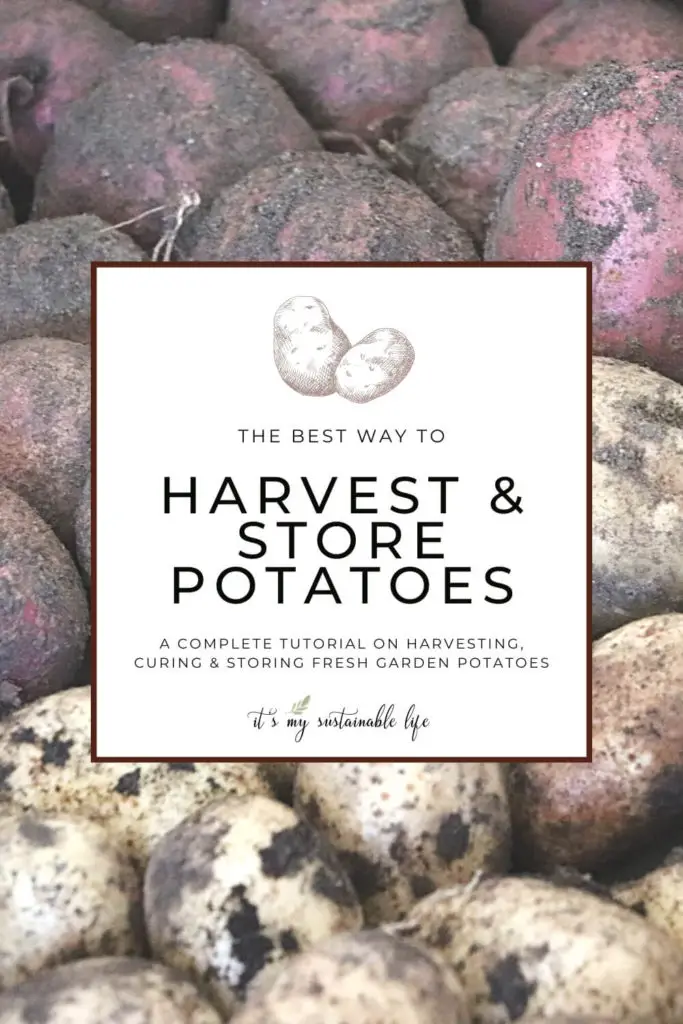
WITHHOLD WATERING
Once your potato plants have completely withered and died back, refrain from watering your potatoes any further. This dry period encourages those potato skins to harden or “set”, setting them up for successful long-term storage.
WEATHER & TIMING MATTERS
Determining the “when” to dig up your potato harvest is always somewhat of a guessing game. I keep a watchful eye on the weather for frost predictions and try to time my harvest accordingly.
Try to time your digging up the gold on a dry day, one where it’s been a few days with no rain. Ideally, you want the soil to dry before harvesting your potatoes. It’s just easier digging (your back will thank you) and the potatoes will dry & cure more readily.
All that being said, it’s almost inevitable that a stray tuber was missed during the harvest only to offer you a surprise volunteer plant the following year 😊
HOW TO DIG POTATOES UP
Depending on how you grew your potatoes, in the ground, in containers, or in potato bags, will determine how you go about digging the potatoes up.
If you grow your potato crop in grow bags or containers, to harvest your potatoes is a simple matter of dumping the container over and gathering the potatoes up.
Alternatively, if you have a garden wash screen and are able to pick the container up, you can pour the contents out on the screen. Hopefully the dirt & soil will flow through the screen leaving the spuds & plant material to be separated.
When you’ve grown your potatoes directly into the ground, harvesting should be approached a bit differently. And with care.
As those stolons grow in a 12-18 inch diameter, give care when approaching your potato bed with a garden fork or garden spade.
Alternatively, should you have nice loose soil, you can simply use your hands to dig into the soil to remove the tubers or simply pull the whole plant up, tubers & all. Unfortunately for me, my soil has a lot of clay and compacts fairly easily. Thus, garden fork for me 😊
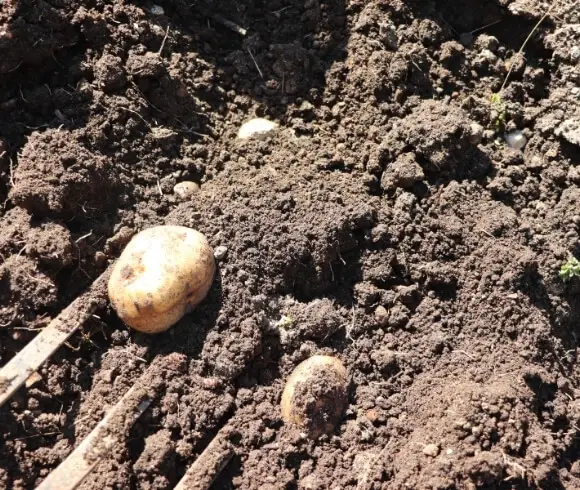
Erring on the side of caution, when using a garden fork or spade, dig straight down into the soil (not at an angle) 12 to 18 inches away from the plant stem & deep enough that you are far below the base of the plant (I usually approximate how deep I originally planted the chitting potato piece) and lift up trying your best not to accidentally stab any of the tubers.
Should you cut into or stab any (it inevitably happens no matter how careful I am), I store these on separately after curing for use first. Damaged potatoes will not have a long shelf life no matter how careful you are in curing & storing.
SHOULD POTATOES BE WASHED BEFORE STORING
In a nutshell? No. Washing your potatoes before storing will make them look pretty, but will shorten their storage life.
I place all my freshly harvested potatoes in my garden cart as is, and place the garden cart in a dark corner of my garage. No brushing the soil off, no washing, no nothing. As is. Freshly harvested garden potatoes are still tender. Their skins have not cured or hardened and will be prone to injury when handled too roughly.
If you’ve been able to utilize a garden washing screen, all the better. The potatoes will have good air-flow and the soil will dry and fall off pretty much all on its own and in fairly quick time. Just be sure they are in a shaded area and out of sunlight as they will turn green rather quickly.
HOW TO CURE POTATOES AFTER HARVESTING
Curing means to simply harden off the potato. To harden and further toughen up the skin, lengthening the storage life exponentially.
To cure your harvested potatoes, place them in a single layer in a dark, well ventilated area with moderate (50° to 65° F) temperatures & preferably high humidity (85%). Leave them be for about two weeks to fully cure and be ready to store. That is in a perfect world 😊
For me, curing my potatoes means placing my freshly dug up potatoes into my garden cart, placing the cart in a dark corner of my garage and leaving them be for about two weeks.
Be aware that light is no friend to your freshly dug up potatoes. Tubers exposed to light will turn green, making them unfit for use.
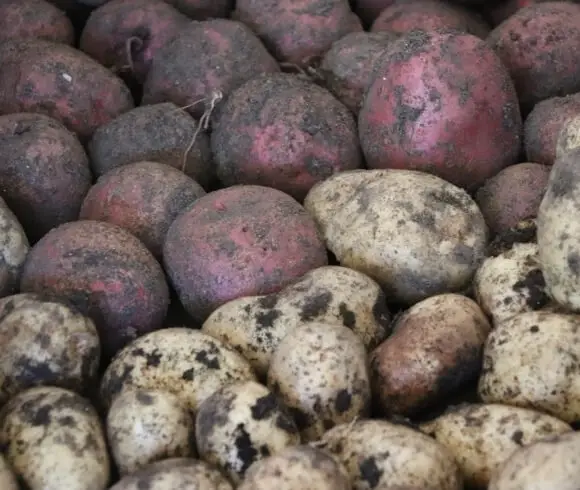
The curing process not only prepares your potatoes for long-term storage, it also helps to heal any scrapes, shallow cuts, or nicks that may have occurred during harvest.
Again, those with deep cuts, bruises, or bites (yes, there are those that have been nibbled on a bit occasionally) should be eaten soon as they will not store well.
HOW TO STORE FRESHLY DUG POTATOES
With proper storing we can plan on enjoying our potato harvest for 7 to 8 months! But temperature matters with storage. And those that are stored in temperatures that exceed 45° F, although they will remain viable for about 2 to 3 months, will begin to shrivel & sprout.
CHOOSING THE BEST POTATOES FOR LONG-TERM STORAGE
Once your curing time is up, sort through the potatoes and choose only the best of the best potatoes to store long-term. Ones that have no visible damage. No bruises, soft spots, and that remain firm to the touch. Eat the strays soon and don’t plan on storing them.
CHOOSING THE BEST CONTAINER TO STORE POTATOES
There are a lot of idea’s on what kind of container is best to store your potatoes. Everything from simple cardboard boxes with slits cut into them for ventilation to purchased wooden storage crates.
No matter if you re-purpose or purchase your chosen container, it should allow for plenty of ventilation. Personally, I store mine in my bushel gathering baskets and fill to halfway full for ease of inspection (more on that below).
CREATING PROPER POTATO STORAGE CONDITIONS
The perfect storage condition for potatoes is maintaining a consistent temperature, the right light conditions, & the right humidity levels.
- TEMPERATURE – Ideal temperature for storage potatoes should be a consistent 40° to 50° F. The warmer the temperature, the quicker your potatoes will begin to sprout
- LIGHT – Potatoes meant for long-term storage should be kept in the dark. Literally. Think dark cold room, basement, or root cellar
- HUMIDITY – Humidity should be moderate, and hover right around 80% to 90% relative humidity. We strive to keep our cold room at 85% to 95% humidity
CHECK STORED POTATOES OFTEN
Don’t forget to go through those stored potatoes, and often, looking for those that are showing decay, shriveling, or sprouting.
Should your potatoes begin to sprout, simply pinch off or knock off the sprout with your hands and discard the sprouts.
Remove any that are showing signs of rot, decay, soft spots etc. immediately as they will promote decay in the whole batch.
ADDITIONAL POTATO STORAGE TIPS & SUGGESTIONS
- Set Yourself Up For Successful Potato Storage – By choosing the right potato for your needs, new potatoes or maincrop potatoes, set yourself up for successfully storing your potato crop by choosing the right varieties. Refer to my list(s) above, consider your climate, and determine which you will be planting for your own potato harvest and potato storage needs.
- Don’t Store Potatoes Near Apples, Fruits, And Onions – Why don’t potatoes play nice near apples, fruits, and onions? The ethylene gases that these food items give off will promote spoilage and early sprouting.
- Potato Reconditioning, What Is It & Why Do It – Yes, you heard right. Potato reconditioning. What does that mean? Potatoes which are kept in cold storage temperatures to slow deterioration, disease, and sprouting may cause your potatoes to turn a bit sweet. This process is also known as “potato cold-induced sweetening”. The process where the starches in potatoes are converted to glucose, fructose, or sugar. No worries, however, as this process can be reverted by simply removing the potatoes for about a week prior to using them, bringing a balance of starch & sugar ratio’s.
- Don’t Store Potatoes In The Refrigerator – Unless you are looking for sweet potatoes for the above reasons 😂. Also, low humidity levels in the refrigerator will cause shriveling.
- Darkness Is The Potatoes Best Friend – Solanine, a colorless alkaloid found in the top 1/8 of the potato skin, is bitter and one of the plants natural defenses. It’s also something that is further developed within the potato when exposed to light during storage. Consumption of large portions of solanine can cause illness with symptoms ranging from diarrhea to abdominal pain and/or vomiting. So peel those green potatoes thoroughly, and should the green extend throughout the potato, discard the whole thing completely.
By planting the proper potato varieties for your needs, making the extra effort to properly harvest and cure your potatoes, and learning the in’s and out’s of proper storage, you too can be sure of enjoying those tasty spuds throughout the winter months.
What are your tips for how to harvest and store potatoes?
Love, Light, & Laughter ~

Enjoy this article? Please consider sharing it on your favorite social media channel! Want more? Subscribe below for the occasional update with all the “happenings on the hill”!
Looking For More Preserving & Storing Tips?
Water Bath Canning For Beginners
13 Ways To Preserve Fresh Herbs
Fermenting Food In A Mason Jar

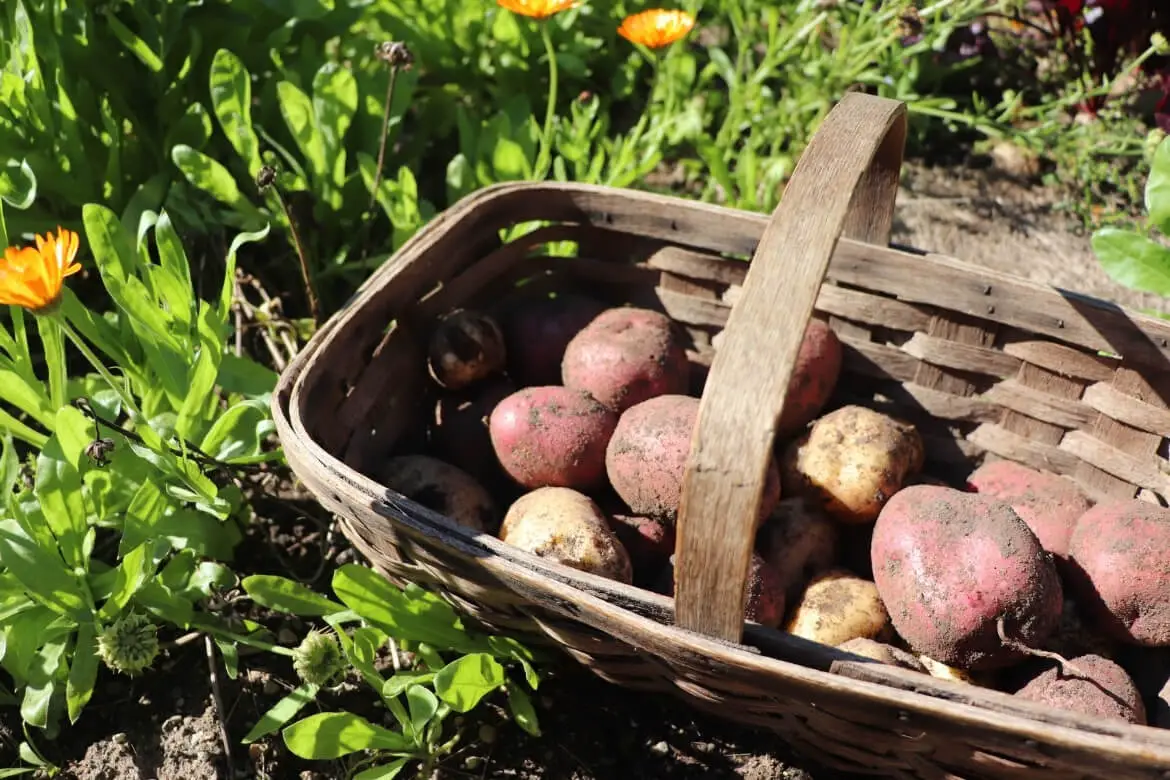

13 comments
Great info on growing potatoes! I have grown my own. It’s a rewarding experience.
It definitely is as that. AND the flavor & texture? Par none!
We are considering growing potatoes but I wasn’t sure about the process of harvesting and storing them. Sounds fairly straight forward so we may give it a go next year 🙂
I love potatoes! It looks like it would be very satisfying digging them up from the ground. You have a lot of great info!
Perfect Timing! Mine are dying back. I tried planting in a few different locations this year, one being large buckets. Those died back and I checked and they’re all small. Is this because of space? I ahven’t done much with potatoes so I wasn’t sure if they’re like carrots and just grow to teh spae they have.
Thanks for sharing with us on the Homestead Blog Hop by the way 🙂
Potatoes grown in containers will tend to be on the smaller side. Consider them “new potatoes” 😊. Happy you enjoyed & found the info of help!
This was quite interesting! I didn’t know potatoes need a dry period to set!
I had no idea all the particulars of growing a potato, or even that a new potato was just a young potato. No wonder mine have never turned out well. I’m re-motivated to try again with this!
You have a lot of great information here! I’ve never grown potatoes, but maybe I’d like to try someday. I store my purchased potatoes in a dark cabinet in the kitchen, but I didn’t really know why. That’s just what my mom did. I see why you keep them in the dark now!
Now I had to do research if we can grow potatoes in our area. I know Idaho has some good fertile soil for potatoes. I like that they store for so long!
We have left our potatoes in the ground to overwinter with mulch before. They did alright, but without the foliage they were hard to find, and digging nearly-frozen ground wasn’t really all that fun.
But storage was difficult, so we did what we had to do.
Not my idea of fun either! Hopefully, you’ve worked out a better storage system now. Thanks for stopping by, Laurie!
Good tips! I don’t grow potatoes but have been gifted quite a few bags recently and was trying to find out how to help them last longer in our cabinet!